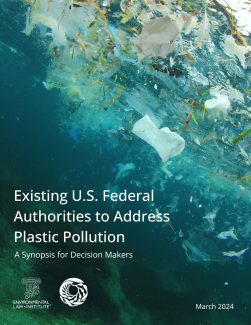The 20th century invention of plastics has produced a 21st century deluge of plastic pollution. This global problem spans from increased production of the materials to their problematic disposal. From 2020 to 2021, I chaired a National Academies of Sciences, Engineering, and Medicine expert committee, charged by Congress—pursuant to the bipartisan Save Our Seas 2.0 Act and funded by the National Oceanic and Atmospheric Administration—to determine the U.S. role in global ocean plastic pollution.
Our committee concluded that the United States must substantially decrease our contribution to global plastic waste, including by producing less plastic. To do so, the nation needs a comprehensive federal policy and research strategy, with interventions at every stage of the plastic lifecycle.
This recommendation is supported by the report’s findings, which showed the United States is a major contributor to global plastic pollution. In addition to being the largest generator of solid waste, in 2016, we were the top generator of plastic waste, responsible for about 42 million metric tons. While the United States has a strong waste management system relative to many countries, a 2020 study in Science Advances by Law, et. al, estimated that plastic solid waste still “leaks” from municipal solid waste at a rate of 1.13-2.24 MMT per year as of 2016. This places our nation as the third to twelfth largest contributor of plastic pollution in the coastal environment. These are likely conservative estimates, as the country lacks data to quantify plastic pollution from transportation, stormwater, and industrial discharges.
The United States also contributes to plastic pollution as a producer and exporter. In 2019, North America produced almost 20 percent of total global plastic, second to Asia, with U.S. production capacity projected to increase. Since the 1990s, U.S. exports of plastic products have been increasing, and we continue to export plastic waste.
This waste is also found across the country in lakes, rivers, in the air, and on land, harming both wildlife and people. The vast majority of plastics lost to the natural environment are persistent contaminants, because they do not readily biodegrade. Additionally, plastic debris can kill or injure wildlife that ingest or become entangled in it. We are learning more about the impacts of microplastics—small plastic particles that travel through air, water, and the food web—on ecosystems and human health. If the amount of plastic pollution continues to increase, these negative consequences will worsen.
There is no single solution, and current federal action is insufficient. We cannot continue to rely on an overwhelmed waste management system or highly inefficient efforts to clean up plastic waste in the marine environment. Nor can we recycle our way out of this growing problem. Today the United States recycles less than 9 percent of its plastic waste. There is limited demand for recycled materials, and current processes and infrastructure are grossly inadequate for the overwhelming volume and complexity of plastics discarded, typically after a brief use.
The path forward is a national systemic strategy designed to address all six stages of the plastic lifecycle:
1) reduce plastic production; 2) innovate in materials and product design; 3) produce less plastic waste; 4) upgrade waste, recycling, and composting programs and infrastructure; 5) increase capture of plastic waste before and after it enters the environment; and 6) decrease direct dumping of plastic waste into the ocean.
A national plastic waste reduction strategy will require high-level federal leadership and coordination. Existing laws and programs, including many at EPA and NOAA, can form the backbone, but the strategy must prioritize actions around all six intervention areas, set national goals, and fill knowledge and policy gaps. Federal leadership is critical to mobilize cross-sectoral collaboration and gather ideas from state and local policy laboratories, which have enacted innovative measures to reduce plastic waste.
Reducing plastic pollution provides co-benefits beyond decreasing waste. It supports innovation and economic opportunity and addresses unequal economic burdens. It also helps achieve U.S. and global climate goals—according to the UN Environment Programme, emissions from plastic production and waste generation are projected to account for at least 15 percent of the global carbon budget by 2050 if current practices continue. Cutting pollution also helps mitigate the disproportionate impacts of plastic production on BIPOC (Black, Indigenous, and people of color) communities, and advances justice.
The time to act is now, and momentum is building. Congress has demonstrated bipartisan support, government and multisector plans are under development, and global treaty discussions on plastic pollution are underway, with the United States finally at the table. We need a national strategy to support negotiations with G7 nations that already have plans of action. The European Union recently banned 10 single-use plastic products under its plastic strategy, and both the EU and Canada have embraced a circular economy approach to address climate change and plastic pollution.
If the United States takes leadership on ocean plastic waste now, Americans can benefit economically from innovation, help shape global design and production trends, and achieve an enormous environmental benefit for generations to come.
Margaret Spring is chief conservation and science officer at Monterey Bay Aquarium. She chaired the Committee on U.S. Contributions to Global Ocean Plastic Waste convened by the National Academies of Science, Engineering and Medicine.



